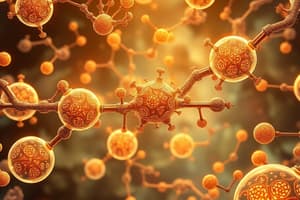Podcast
Questions and Answers
What is a critical aspect of gene expression?
What is a critical aspect of gene expression?
- It requires the transcription of DNA into RNA. (correct)
- It is primarily focused on the replication of DNA.
- It involves the synthesis of carbohydrates.
- It occurs only in the cytosol.
Which statement correctly describes protein structure?
Which statement correctly describes protein structure?
- The quaternary structure is the most basic level of protein organization.
- Proteins have only one level of structure.
- The primary structure determines the three-dimensional shape of the protein. (correct)
- Biophysical methods cannot analyze proteins effectively.
What is the main function of biological membranes?
What is the main function of biological membranes?
- To facilitate the direct exchange of all cellular components.
- To store genetic information.
- To regulate transport and maintain compartmentalization. (correct)
- To aid in the replication of nucleic acids.
How does RNA structure differ from DNA structure?
How does RNA structure differ from DNA structure?
In which process is oxidative phosphorylation involved?
In which process is oxidative phosphorylation involved?
What are carbohydrates primarily used for in living organisms?
What are carbohydrates primarily used for in living organisms?
Which metabolic pathway is central to breaking down glucose?
Which metabolic pathway is central to breaking down glucose?
What is the primary function of enzymes in biological reactions?
What is the primary function of enzymes in biological reactions?
Where does the Citric Acid Cycle primarily occur?
Where does the Citric Acid Cycle primarily occur?
What roles do lipids play in living organisms?
What roles do lipids play in living organisms?
Which process converts light energy into chemical energy?
Which process converts light energy into chemical energy?
Nucleic acids like DNA and RNA are primarily involved in what function?
Nucleic acids like DNA and RNA are primarily involved in what function?
Which pathway uses reducing equivalents from glycolysis and the citric acid cycle to produce ATP?
Which pathway uses reducing equivalents from glycolysis and the citric acid cycle to produce ATP?
Flashcards
Glycolysis
Glycolysis
The process of converting glucose into pyruvate, producing a small amount of ATP and NADH.
Krebs Cycle
Krebs Cycle
A series of reactions that occur in the mitochondria, where pyruvate is oxidized to carbon dioxide, generating ATP and reducing equivalents.
Oxidative Phosphorylation
Oxidative Phosphorylation
The process in which ATP is produced using the energy from the electron transport chain, driven by the movement of protons across the mitochondrial membrane.
Gene Expression
Gene Expression
Signup and view all the flashcards
Protein Structure
Protein Structure
Signup and view all the flashcards
What is biochemistry?
What is biochemistry?
Signup and view all the flashcards
What are carbohydrates?
What are carbohydrates?
Signup and view all the flashcards
What are lipids?
What are lipids?
Signup and view all the flashcards
What are proteins?
What are proteins?
Signup and view all the flashcards
What are nucleic acids?
What are nucleic acids?
Signup and view all the flashcards
What is glycolysis?
What is glycolysis?
Signup and view all the flashcards
What is the citric acid cycle?
What is the citric acid cycle?
Signup and view all the flashcards
What is the electron transport chain?
What is the electron transport chain?
Signup and view all the flashcards
Study Notes
Introduction to Biochemistry
- Biochemistry studies chemical processes in living organisms.
- It examines biological molecules, metabolic pathways, and process regulation.
- It's a crucial science for understanding life at the molecular level.
Fundamental Biological Molecules
- Carbohydrates: Composed of C, H, and O; a primary energy source and structural component. Glucose is a basic example.
- Lipids: Diverse hydrophobic molecules (fats, oils, phospholipids). Key roles in energy storage, membrane structure, and signaling.
- Proteins: Amino acid polymers, essential for diverse functions like catalysis (enzymes), transport, structure, and defense. 3D structure dictates function.
- Nucleic Acids: DNA and RNA are genetic information carriers. DNA stores genetic instructions, while RNA aids in protein synthesis and other cellular roles.
Key Metabolic Pathways
- Glycolysis: A crucial metabolic pathway, breaking down glucose for ATP production in the cytoplasm.
- Citric Acid Cycle (Krebs Cycle): Further oxidizes glycolysis products, generating ATP and reducing equivalents (NADH, FADH2). Occurs in the mitochondrial matrix.
- Electron Transport Chain (ETC): Utilizes reducing equivalents from glycolysis and the Krebs Cycle. Generates a large ATP yield through oxidative phosphorylation across the inner mitochondrial membrane.
- Photosynthesis: Plants and some bacteria convert light energy to chemical energy (glucose).
Enzyme Catalysis
- Enzymes are biological catalysts, speeding up reactions without being consumed.
- They lower activation energy for reactions.
- Factors like temperature, pH, and substrate concentration influence enzyme activity.
Cellular Respiration
- Cellular respiration extracts energy from organic molecules to make ATP.
- It breaks down glucose and other fuels for ATP production.
- Key stages include glycolysis, the Krebs cycle, and oxidative phosphorylation.
Gene Expression
- Gene expression uses gene information to create functional gene products.
- This usually involves DNA transcription to RNA, followed by RNA translation to proteins.
- Gene expression is tightly regulated for precise protein production.
Protein Structure and Function
- A protein's amino acid sequence defines its unique 3D structure.
- Primary, secondary, tertiary, and quaternary structures are essential for function.
- Biophysical methods like X-ray crystallography and NMR analyze protein structures.
Biological Membranes
- Biological membranes are critical for compartmentalization and transport regulation.
- Primarily composed of phospholipids and proteins.
- Membranes are selectively permeable, controlling molecule passage.
Nucleic Acid Structure and Function
- DNA has a double helix structure, stabilized by hydrogen bonds.
- RNA structure varies by type (mRNA, tRNA, rRNA).
- Nucleic acid roles are primarily in information storage and transfer.
Studying That Suits You
Use AI to generate personalized quizzes and flashcards to suit your learning preferences.




